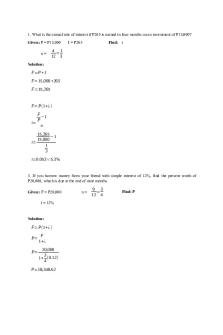Worksheet 13 (answers might be incorrect) PDF

| Title | Worksheet 13 (answers might be incorrect) |
|---|---|
| Author | Meet Patel |
| Course | Lab-Mbio 2815-010 |
| Institution | University of Oklahoma |
| Pages | 1 |
| File Size | 112.2 KB |
| File Type | |
| Total Downloads | 61 |
| Total Views | 140 |
Summary
Worksheet 13 (personal answers)...
Description
Name: Meet Patel
Section:
014
Worksheet 13: Transformation Below are results from a transformation based on the procedure you had conducted. Using the results below answer question 1.
1.
Plate
No Plasmid
+ Plasmid
LB plate
Hundreds of colonies
----------
LB/ampicillin plate
no colonies
20 colonies
Was the transformation successful? Explain. (1.0 pt)
Yes, the transformation was successful. We saw the expected results for E. coli (No plasmid, LB plate) to see hundreds of colonies. For E. coli (No plasmid, LB/ampicillin plate) we saw no growth on the plate which was due to no presence of plasmid. For E. coli (+ plasmid, LB/ampicillin plate) we saw growth on the plate which was due to presence of plasmid. Thus, the transformation of E.coli was successful since with the presence of plasmid we observed the growth on LB/ ampicillin plate. 2.
Clumsy McForgetful used the same plasmid and LB/amp plates as you used in lab, but his transformation was unsuccessful. What could be one reason Clumsy’s transformation did not work? (1.0 pt)
1. Not performing heat shock or incorrectly performing heat shock. 2. The temperature and length of the incubation period. 3. Improper use of cell-spreading tools.
3.
What was the purpose of plating the “no plasmid” condition on the LB/ampicillin plate? Is it considered a positive control or a negative control? (1.0 pt)
E. coli with “No plasmid” condition on the LB/ ampicillin plate: It acts as a control to confirm that bacteria cannot grow in the presence of ampicillin. It is considered a negative control. Ampicillin is an antibiotic and works by preventing E. coli from constructing cell walls, thereby killing the bacteria. If the bacteria are viable on the LB/amp plate, then they are resistant to ampicillin. If no bacterial colonies survive, then they were not ampicillin resistant (they were ampicillin sensitive)....
Similar Free PDFs

Worksheet Ch 13 answers 2021
- 3 Pages

Worksheet 13
- 2 Pages

1. \'To Be\' Practice Worksheet
- 5 Pages

Lab 13 - Lab worksheet
- 6 Pages

MAY et Might
- 17 Pages

Chapter 13 - Exam answers
- 70 Pages

Chapter 13 - Testbank Answers
- 11 Pages

Exam chapter-13-, answers
- 28 Pages

Topic 13 answers
- 1 Pages

Ch 13 answers
- 10 Pages

Accounting chapter 13 answers
- 20 Pages

Cell 13 answers
- 25 Pages

Chapter 13 review answers
- 5 Pages
Popular Institutions
- Tinajero National High School - Annex
- Politeknik Caltex Riau
- Yokohama City University
- SGT University
- University of Al-Qadisiyah
- Divine Word College of Vigan
- Techniek College Rotterdam
- Universidade de Santiago
- Universiti Teknologi MARA Cawangan Johor Kampus Pasir Gudang
- Poltekkes Kemenkes Yogyakarta
- Baguio City National High School
- Colegio san marcos
- preparatoria uno
- Centro de Bachillerato Tecnológico Industrial y de Servicios No. 107
- Dalian Maritime University
- Quang Trung Secondary School
- Colegio Tecnológico en Informática
- Corporación Regional de Educación Superior
- Grupo CEDVA
- Dar Al Uloom University
- Centro de Estudios Preuniversitarios de la Universidad Nacional de Ingeniería
- 上智大学
- Aakash International School, Nuna Majara
- San Felipe Neri Catholic School
- Kang Chiao International School - New Taipei City
- Misamis Occidental National High School
- Institución Educativa Escuela Normal Juan Ladrilleros
- Kolehiyo ng Pantukan
- Batanes State College
- Instituto Continental
- Sekolah Menengah Kejuruan Kesehatan Kaltara (Tarakan)
- Colegio de La Inmaculada Concepcion - Cebu


